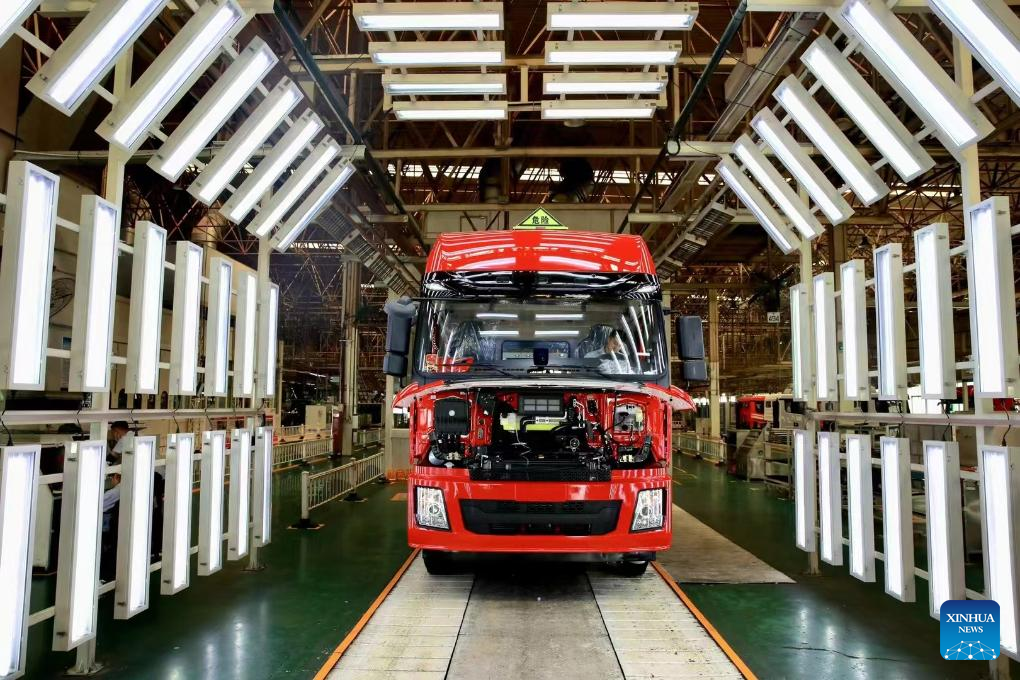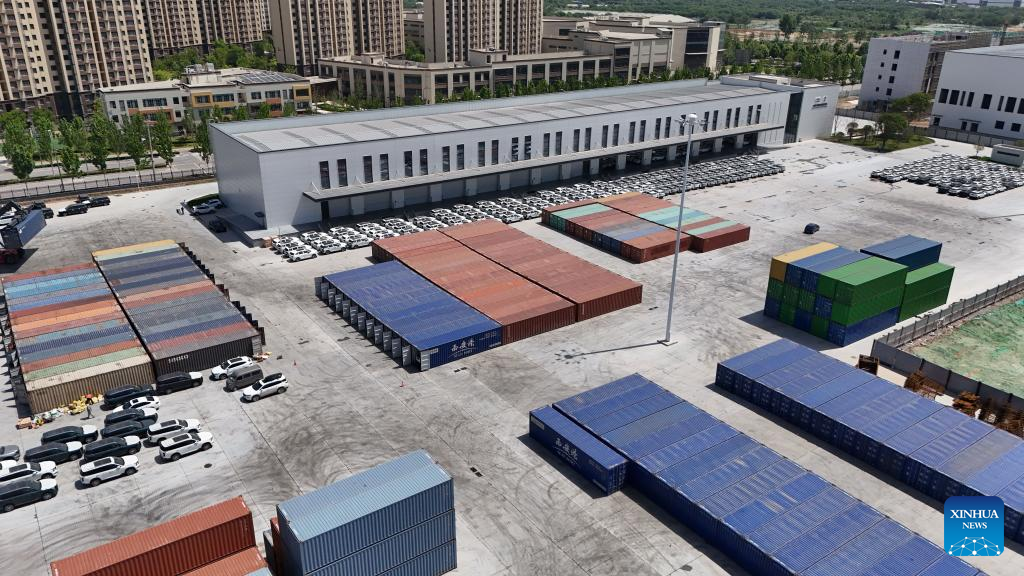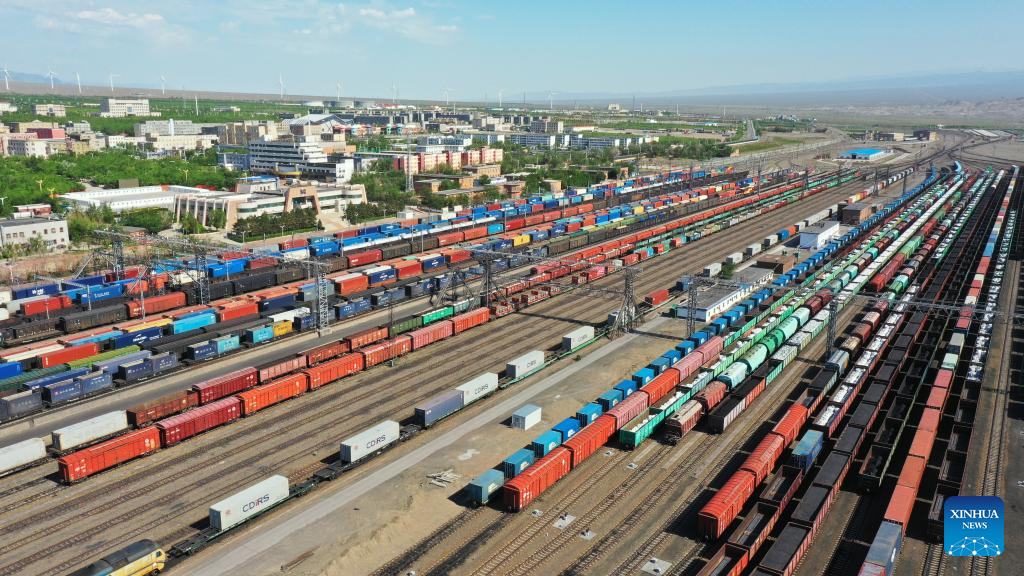China, Central Asia reap remarkable benefits from win-win cooperation
 0 Comment(s)
0 Comment(s) Print
Print E-mail Xinhua, May 22, 2024
E-mail Xinhua, May 22, 2024

This photo taken on May 15, 2024 shows a truck plant of the Shaanxi Automobile Holding Group Co., Ltd. (SHACMAN) in Xi'an, northwest China's Shaanxi Province. (Xinhua/Zhao Yingbo)
XI'AN, May 20 (Xinhua) -- Xiao Qiqing, a university student in Xi'an, capital of northwest China's Shaanxi Province, is brimming with excitement for her graduation trip to Almaty, Kazakhstan, next month.
"I searched online and found that Almaty has unique natural scenery and a fascinating artistic vibe. Thanks to visa exemption and the direct flight, I can just pack and go," she said.
About 217,000 Chinese tourists visited Kazakhstan in 2023, Kazakhstan's Ambassador to China Shakhrat Nuryshev said last month. The ambassador added that as this year marks the Kazakhstan tourism year in China, over 35 relevant activities will be held in cities such as Beijing, Shanghai and Xi'an.
Increasing cross-border travel is only one facet of deepening ties between China and Central Asia. One year ago, the first China-Central Asia Summit in Xi'an set a new platform for good neighborliness and win-win cooperation between China and five Central Asian countries, namely, Kazakhstan, Kyrgyzstan, Tajikistan, Turkmenistan, and Uzbekistan.
Over the past year, by tapping into the potential of transportation and infrastructure and creating new growth drivers like agriculture, the six countries have delivered tangible benefits for the region's people and local economy.
EFFICIENT CONNECTIVITY NETWORK
The Alashankou Port in northwest China's Xinjiang Uygur Autonomous Region begins its bustling days at dawn. As a key gateway of the New Eurasian Land Bridge, it serves as both a vital passage to Central Asia and Europe and a crucial hub for international trade and cooperation.
The port has streamlined its services since last year, reducing the reloading time for inbound trains to less than an hour. In the first four months of this year, 2,489 China-Europe (Central Asia) freight trains passed through the Alashankou Port, marking a year-on-year increase of 17.1 percent.
Enhancing connectivity with Central Asia is one of the commitments China made at the summit. Since then, the country has been striving to modernize the border ports and increase the volume of cross-border cargo transportation.
Xinjiang has opened five "green lanes" for streamlined customs clearance of agricultural and sideline products by cooperating with Kazakhstan, Tajikistan and Kyrgyzstan.
According to Urumqi Customs, in the first quarter of 2024, Kazakhstan and Kyrgyzstan remained Xinjiang's major trading partners, with import and export growth of 58.8 percent and 1.9 percent, respectively, accounting for 40.5 percent and 22 percent of Xinjiang's total foreign trade.
China-Kazakhstan (Xi'an) Trade Logistics located in Xi'an, the eastern starting point of the ancient Silk Road, is also a major outcome of the summit.
Although located in the heartland, Xi'an is one of the China-Europe Railway Express assembly centers. It launched 1,047 China-Europe freight trains in the first quarter of this year, with one train leaving or arriving at the Xi'an international port station every 100 minutes on average.
The freight terminal, jointly launched by KTZ Express, a subsidiary of Kazakhstan's national railway company Kazakhstan Temir Zholy (KTZ), and Xi'an Free Trade Port Construction and Operation, facilitates an efficient "hub-to-hub" logistics corridor.
According to KTZ, China-Kazakhstan rail cargo volume rose by 22 percent annually to 28 million tonnes in 2023.
"The aim of the terminal in Xi'an is for it to be a transfer hub and warehouse so that goods can be transferred between China, Kazakhstan, Central Asia and even Europe and other places more efficiently," said Sadvakkas Seitzhanov, general manager of the Chinese branch of KTZ Express, noting that with the terminal, the transit time from Xi'an to Tashkent in Uzbekistan has been reduced from 13 days to 9 days.
"We adjust the shipment schedule based on real-time market demand, and share information about the train service and provide one-stop service to our clients. The booming bilateral trade in recent years has given us the confidence to expand business in China," he added.
MUTUALLY BENEFICIAL COOPERATION
With summer approaching, many locals in Xi'an now can enjoy a fresh scoop of ice cream made in Kazakhstan.
A customer at a supermarket of Xi'an Aiju Grain and Oil Industrial Group expressed her delight after savoring the creamy and flavorful Kazakh vanilla ice cream with a chocolate topping.
According to Liu Dongmeng, deputy general manager of the Xi'an Aiju Grain and Oil Industrial Group, over 40 percent of products in the supermarket were imported from Central Asian countries, including beer, biscuits and honey, which are widely popular among Chinese customers.
Relying on the steady demand in the Chinese market, the company has begun promoting order-based agriculture in Kazakhstan by offering local farmers guaranteed purchase prices since 2016. To date, the planting area covers 1.5 million mu (about 100,000 hectares), with an additional investment of 150 million yuan (about 20.78 million U.S. dollars) made in 2023 for grain processing.
The two-way trade between China and the five Central Asian countries has been propelled to new heights, with the trade volume soaring 17.9 percent in the first four months of this year, according to official data.
Booming foreign trade has also been reported in other industries such as truck manufacturing. For instance, the Shaanxi Automobile Holding Group Co., Ltd. (SHACMAN) exported more than 7,500 heavy trucks to Central Asian countries in 2023, up 110 percent year on year.
By building factories and service stations in these countries, SHACMAN has offered training courses to local staff and gained a foothold in the Central Asian market.
The company customized the design and performance of its trucks to meet the specific needs of users. For example, trucks exported to Central Asian countries are equipped with independent warm air systems and thermal insulated cabs to withstand cold conditions.
"We also tailor the products to suit each country's needs. Tajikistan requires more dumpers for its mining industry and infrastructure projects, whereas long-distance tractors are popular in Kazakhstan for the trans-Caspian international transportation corridor," said Hui Xiang, brand manager of Shaanxi Heavy Duty Automobile Import & Export Co., Ltd., an affiliate company of SHACMAN. ■

An aerial photo taken on May 14, 2024 shows the China-Kazakhstan (Xi'an) Trade Logistics in Xi'an, northwest China's Shaanxi Province. (Xinhua/Zhao Yingbo)

An aerial photo taken on May 17, 2024 shows a view of the Alashankou Port in northwest China's Xinjiang Uygur Autonomous Region. (Xinhua)


